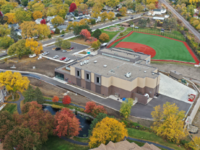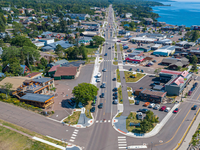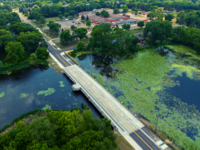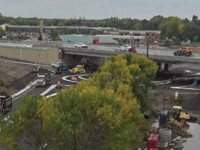Awards
For more than 30 years, the APWA-MN Chapter has sponsored an annual Awards Program that recognizes excellence in public works. In addition, the chapter actively supports the APWA Awards Program with multiple submissions to the annual national awards program.
Learn more about awards and winners in the tabbed section below.
Chapter Awards
Hugo G. Erickson Award

John Rodeberg
SEH
The 2023 Hugo G. Erickson Award has been presented to John Rodeberg, Principal Senior Client Service Manager with SEH.
This award is presented each year to an individual who has provided superior and outstanding service to the Minnesota Chapter to further the continued success of the chapter's goals and operation.
John has been an active chapter member for more than 32 years. His chapter service includes serving as chapter president in 2014, on the Executive Committee as Director - Outstate from 2003-2005, and on numerous chapter committees. Additionally, John was named the 2002 City Engineer of the Year by the City Engineers Association of Minnesota and was honored as the "Favorite Public Employee" by a Hutchinson Leader newspaper poll in July 2006. He has also received numerous awards from the Local Road Research Board and League of Minnesota Cities.
John's professional highlights include:
- Hutchinson Light Traffic Project: Creating a pedestrian- and bicycle-friendly community through education, enforcement and design
- Hutchinson Area Transportation Services (HATS) Facility: Combined city/county/state maintenance services coordinated by Joint Powers Board
- Trunk Highway 22 Bypass
- Trailblazer Area Transit: City of Hutchinson, McLeod and Sibley counties, State of Minnesota
Public Works Employee of the Year

Emma Struss
Emma Struss, Sustainability Coordinator for the City of Bloomington, is the APWA-MN Public Works Employee of the Year.
Emma's nomination and selection for this award center around her efforts to develop the Bloomington Time of Sale Energy Disclosure Program. The addition of energy disclosures to the city's previous Time of Sale inspection program required initiative to see the need, develop the program mechanics, and guide the development of a new ordinance. Implementaiton of the program also required diplomacy to garner cooperation from other city staff and project partners, enthusiasm to promote the program to residents and realtors, and follow through to make sure information developed through the program is converted to action.
Learn more about Emma and her leadership related to Bloomington's Time of Sale Energy Disclosure Program.
Supervisor of the Year

Mike Olmstead
The 2023 recipient of the Supervisor of the Year Award is Mike Olmstead, Permits Supervisor for Hennepin County.
For the past 15 years, Mike has provided outstanding customer service for the Permits Group, where Mike and his team issue and oversee over 2,500 permits in a typical year. Mike and his team are also responsible for management of the Adopt-A-Highway and Utility Infrastructure Integration programs as well as municipal separate storm sewer system permit compliance monitoring.
Mike is always willing to help beyond his required duties and over the years has volunteered with numerous outreach and education programs that enhance the public perception of public works, including conducting tours for groups visiting the public works facility, facilitating Business Training Experts sessions, organizing project tours for student outreach programs, and more.
Mike is a great mentor to team members in supporting their professional growth and is sought by others within Transportation Operations as well as others in public works to gain his insight and guidance.
Engineering Technician or Field Personnel

Brian Dahlberg
Brian Dahlberg is the 2023 APWA-MN Engineering Technician of the Year.
An Engineering Tech III with the City of Golden Valley, Brian has worked in progressive roles with the city since 1985. He has mentored countless interns over several decades, contributing to the skills and growth of many successful public works professionals.
Brian is Golden Valley's go-to person for staking miscellaneous city projects because of his experience and attention to detail. During the winter, Brian assists with project development and is the city's lead on record drawing updating. He developed a process for updating record drawings and ensuring each new drawing has the correct content and formatting to fit city standards.
Project of the Year - Environment

Robbinsdale Water Infrastructure Transformation
The APWA-MN Project of the Year in the Environmental category is presented to the City of Robbinsdale for the Robbinsdale Water Infrastructure Transformation project.
Managing Agency: City of Robbinsdale
Project Partners: AE2S, Gridor Construction
Project of the Year - Outstate

TH 61 Reconstruction in Grand Marais
The APWA-MN Project of the Year in the Outstate category is presented to the City of Grand Marais for the TH 61 Reconstruction Project.
Managing Agency: City of Grand Marais
Project Partners: LHB, MnDOT, KGM Contractors
Project of the Year - Structures

Duck Lake Road Reconstruction
The APWA-MN 2023 Project of the Year in the Structures Category is presented to the City of Eden Prairie for the Duck Lake Road Reconstruction project.
Managing Agency: City of Eden Prairie
Project Partners: Bolton & Menk, Kraemer North America LLC
Project of the Year - Transportation

Highway 10/169 Improvements
The APWA-MN 2023 Project of the Year in the Transportation category is presented to the City of Anoka for the Highway 10/169 Improvements project.
Managing Agency: City of Anoka
Project Partners: Bolton & Menk, Kraemer North America LLC, Shafer Contracting Co.
National Awards
Top Ten Public Works Leaders of the Year
Russ Matthys, PE
The American Public Works Association – Minnesota Chapter is proud to recognize 2020 Chapter President Russ A. Matthys, PE, as the 2023 APWA recipient of the Public Works Top Ten Leaders of the Year Award.
Russ has been a dedicated member of APWA since 1995 and has continually provided outstanding service to the communities he’s worked in and
to numerous professional and community organizations, including APWA. Russ began his career in the late 1980s working at various consulting firms in California before he eventually relocated to Minnesota to become an assistant city engineer at two different twin city metro area
suburbs. In 1997, Russ became the city engineer for the City of Eagan and was promoted to Public Works Director in 2012. Russ has continued to serve Eagan in this capacity where he currently manages a department consisting of over 60 full-time staff and a $32 million annual operating budget.
Russ has volunteered at numerous educational and STEM outreach events to educate and help generate interest in the engineering and public works fields at local area schools. Over the years Russ has also found time to help the Minnesota Chapter with his time and talents by volunteering on numerous Chapter committees, serving on the Chapter’s Executive Committee and eventually as the Chapter President in 2020. To recognize Russ for all his efforts on behalf of the Chapter, he was honored with the Minnesota Chapter Hugo G. Erickson Award for Chapter Service at the Chapter’s fall conference in November 2022.
Harry S. Swearingen Award for Outstanding Chapter Achievement and Excellence in Chapter Service - Corporation
Metropolitan Council Environmental Services
The Metropolitan Council is the regional policy-making body, planning agency and provider of essential services for the Minneapolis-Saint Paul metropolitan region for more than 50 years. The region includes nearly 3 million people in seven counties comprised of 182 cities and townships. The Environmental Services division operates nine wastewater treatment plants and 637 miles of regional sanitary sewer interceptors that collect wastewater from 5,000 miles of local sewers owned by 111 communities in our service area. Environmental Services provides wastewater service to approximately 2.8 million people, which equates to roughly half of the state’s population. We also provide integrated planning to ensure sustainable water quality and water supply for the region. Environmental Services strives to protect the health, safety, and welfare of the public and the environment, including the receiving waters of the Mississippi, Minnesota, and St. Croix rivers.
Being actively involved in the American Public Works Association is essential for the Met Council. Membership in the Minnesota Chapter (APWA-MN) provides an opportunity for Environmental Services staff to develop relationships with our customers and remain cognizant of local planning efforts and day-to-day challenges in public works. These relationships have resulted in many partnering opportunities, as many of our wastewater construction projects align with other local infrastructure improvements. Membership has also provided opportunities for Environmental Services staff to act as convenors to lead discussions related to wastewater service needs and how they may be best achieved.
Public Works Project of the Year - Transportation, $25 million - $75 million
City of Minneapolis for the Hennepin Ave. Downtown Reconstruction Project
The Hennepin Avenue Downtown Reconstruction project extends from Washington Avenue to 12th Street in the heart of the central business district. The City of Minneapolis initiated the project to repair and replace street and utility infrastructure that had reached the end of its useful life. More than 40,000 users use the corridor per day walking, biking, riding transit, and driving, and the reconstruction sought to rebalance the street consistent with the City’s Complete Streets Policy.
Hennepin Avenue was last reconstructed more than 30 years ago, and the sewers under the streets were built in 1882; both the street and the underground utilities needed to be replaced to meet current and future needs of the City. The infrastructure needs also provided an opportunity to revitalize the streetscape and support the activities of the businesses and arts organizations in the Hennepin Avenue Theater District.
The streetscape design was the most important consideration for some stakeholders, as the area is visited by more than 250,000 theater patrons per year and many thousands who come downtown to attend events at Target Center, Target Field, and First Avenue. Making the street green and safe was identified as a high priority, but there was also a need to accommodate large event crowds and provide space for activation.
It also was key that the street not look like a typical city street—the design needed to convey the feeling of being “special” while still achieving the project’s transportation goals. A few design highlights from the completed reconstruction include: installing custom light poles that were designed to take their influence from theater sets, enhancing transit stops to make the corridor bus rapid transit-ready, planting more than 112 new mature trees, more than 3,510 perennials, and 205 shrubs, adding a sidewalk-level protected bikeway, and replacing the aging (built in 1882) sanitary sewer trunk main.
Investing in the public infrastructure to support the continued growth and vitality of downtown Minneapolis is a primary goal for the City. The Hennepin Avenue Downtown Reconstruction project has helped the City remain competitive in attracting private dollars to the corridor, as evidenced by the more than $500 million in new investment that has already been put back into the area along Hennepin Avenue even before the street was completed.
Public Works Project of the Year: Small Cities/Rural Communities - Environmental
City of Pine River for Pine River's Rock Riffle Project
The Pine River dam was built in 1910. The dam was approximately 200 feet long and 13 feet high and created a reservoir upstream including the 500-acre Norway Lake. Electricity was generated at the dam until 1946. Trunk Highway 84 was built on the dam embankment. The highway included a concrete bridge to span the spillways of the dam. The dam was classed as high-hazard and was also a significant fish barrier. The project purpose was to remove the high hazard dam and install a rock riffle in its place.
The dam was removed and replaced with a rock-arch rapids in 2022 by the City of Pine River. Replacing the high hazard dam with a rock riffle enhanced fish passage, biological connectivity, habitat, safety, aesthetics, fishing, and recreational access to the river. The riffle pools and channels enhanced recreational opportunities for wading, fishing, paddling, and other water-based fun. This work restored fish passage and connectivity between the Whitefish Chain of Lakes and reconnected 134 lakes (11,338 acres) and 80 miles of river and stream corridors benefiting fish, mussels, and many game and non-game animal species.
Public Works Project of the Year: Small Cities/Rural Communities - Transportation
City of Moorhead for the Southeast Main Ave. 20th/21st St. Railroad Grade Separation Project
The City of Moorhead is bisected by five active freight rail tracks, one of which also carries AMTRAK passenger service, impacting the city in numerous ways. Currently, 35+ trains a day pass through this area in Moorhead according to FM Metro COG. This has greatly affected the City’s planned program of community improvements aimed at revitalizing the central business district and facilitating new development in rapidly growing areas. The redevelopment efforts involved Moorhead’s citizenry, local planning and transportation agencies, area businesses, and other civic organizations and great amount of public testimony gathered during the planning process documented concerns shared by businesses and citizens that a comprehensive rail safety program was needed – one that would fully implement the community’s vision. Without rail safety improvements, it was felt that community revitalization could not be fully achieved.
The SE Main Avenue/20th/21st Street Railroad Grade Separation project was identified as a priority element of the City’s 20-year Comprehensive Rail Safety Strategy that has become critical to the downtown’s revitalization and the community’s development program. The strategy aims to minimize the impacts of heavily used freight and AMTRAK rail trackage through the heart of the city while maximizing bicycle, pedestrian, and vehicular safety. The City can now capitalize on the substantial infrastructure investments it has already made, including this project, and continue its successful economic redevelopment program and promote new development.
The project entailed constructing three grade-separated highway underpasses of the Burlington Northern Santa Fe (BNSF) and RailAmerica/G&W railroads at the skewed intersection of SE Main Avenue and 20th/21st Street in Moorhead. This project enables high volumes of vehicle traffic (including a large number of school buses), bicyclists, pedestrians, and transit vehicles to safely and efficiently move through the heavily traveled junction of these arterial streets and two freight rail lines. It included:
- Construction of a “wye” rail connection that improves northbound-to-eastbound and westbound-to-southbound train movements, allowing trains to directly travel eastbound to the BNSF Rail Yard, located in Dilworth. Prior to this project, trains blocked three to five high-volume, at-grade railroad crossings in downtown Moorhead while they were forced to wait for trains to back up into the yard.
- Construction of various ancillary improvements, a pump station, discharge pipes, retaining walls, and related utility relocations to enhance public safety and environmental sustainability.
- Construction of sidewalks and trails along SE Main Avenue, 20th Street, and 21st Street, which closed gaps in the metro bicycle/pedestrian system and greatly improved pedestrian and bicycle safety.
Public Works Project of the Year - Historical Restoration, less than $5 million
City of Minneapolis for the 10th Ave. SE Bridge Rehabilitation Project
The 10th Avenue SE Bridge in Minneapolis is a critical transportation element that crosses over the Mississippi River near the University of Minnesota. Each day, the bridge carries approximately 10,000 motor vehicles as well as hundreds of bicyclists and pedestrians. Built in 1929 and serving the City for more than 90 years, the bridge is listed on the National Register of Historic Places.
The 10th Avenue SE Bridge is 2,163 feet in length, nearly 70 feet wide and features 21 spans (seven main concrete arch river spans and 14 approach spans). The bridge is one of the highest (115 feet above the river) and longest concrete arch bridges in the Midwest. Short Elliott Hendrickson Inc. (SEH®) and Olson & Nesvold Engineers (ONE) worked with the City of Minneapolis on this crucial rehabilitation project. In the years leading up to this project, leaking expansion joints and drainage elements led to deterioration of critical concrete components on the seven-span concrete arch segment. This deterioration was a mixture of freeze-thaw damage and corrosion from years of de-icing chemical use. SEH, ONE, and the City led a project that implemented a thorough rehabilitation, including removal and replacement of the entire deck of the concrete arch span portion of the bridge. This was a challenging and complex project because the 10th Avenue Bridge is both a historic structure and one of the largest concrete arch bridges in all of the Midwest.
Presidential Award for Chapter Excellence
Minnesota Chapter
The Minnesota Chapter is proud to accept the Presidential Award for Chapter Excellence (PACE) Award for the 19th year in a row.
The Minnesota Chapter of the American Public Works Association is proud to remain a highly involved and active Chapter. Minnesota’s membership continues to stay strong despite the significant work force retirements, retention and inflationary challenges of 2022 and continued to grow from 1,070 to 1,098 members. The Chapter continues its efforts to value and put into practice the goal of engaging its retired members in areas of interest to them, as well as supporting Young Professional involvement and encouraging their mentoring of Student Chapter members to build a solid APWA presence on University campuses throughout Minnesota. 2022 saw the complete return back to in-person conferences and activities, including a new fall conference venue location, and the Minnesota Chapter continues its efforts to offer numerous meaningful networking and educational benefits in 2023. Each year, the Chapter sees more member volunteerism and outreach in educating the public about the value of public works. Further, the Chapter provides valuable opportunities for members to be involved, gain continuing education, network with their peers through committee work, chapter outreach, semi-annual conferences, technical tours, etc. The Executive Committee strives to provide exceptional value for all Chapter members, and the Chapter’s Volunteer Coordinator also plans two new members Meet and Greet events annually.
What's New
-

Young Professionals Spotlight
March 25, 2024
-
Apply for the Young Professionals Stipend: Attend PWX Atlanta
February 23, 2024
-

2024 APWA-MN President's Message
January 25, 2024



